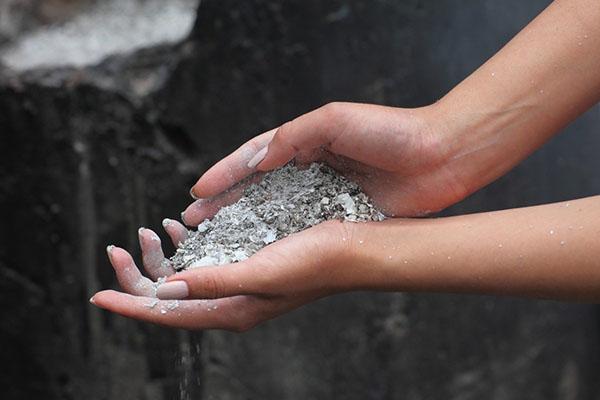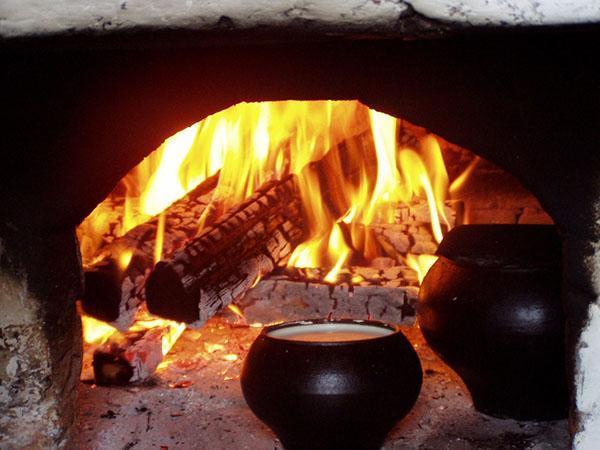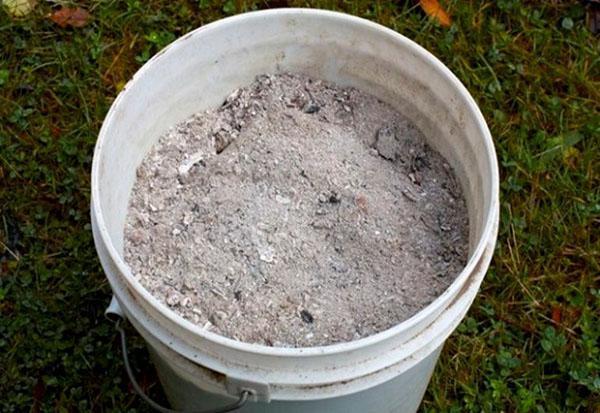101 ways to use ash in the household
 It is good to sit near the Russian stove and look at the hot flame. Tongues of fire embrace the merrily gurgling cast iron and slowly add logs, leaving behind smoldering coals and heaps of ash. Before the new kindling, the cooled ash is collected with a scoop and thrown into the backyard. Occasionally, a zealous owner scatters ash in the fall over the beds and under the plantings, but the scope of its application is much wider. We will find out where else ash is used, what types it is and what substances it contains.
It is good to sit near the Russian stove and look at the hot flame. Tongues of fire embrace the merrily gurgling cast iron and slowly add logs, leaving behind smoldering coals and heaps of ash. Before the new kindling, the cooled ash is collected with a scoop and thrown into the backyard. Occasionally, a zealous owner scatters ash in the fall over the beds and under the plantings, but the scope of its application is much wider. We will find out where else ash is used, what types it is and what substances it contains.
Ash types and chemical composition
 You can burn everything that burns, and at the same time get ash. But not all ash will be useful. Therefore, they usually consider 3 types of it:
You can burn everything that burns, and at the same time get ash. But not all ash will be useful. Therefore, they usually consider 3 types of it:
- woody;
- vegetable;
- coal.
Ash obtained from burning wood, plant residues (dried stems of various plants) and coal (stone and brown) differs in the content of trace elements. The differences are clearly shown in the tables:

As can be seen from the tables, the basis of ash is 3 chemical elements - potassium, phosphorus and calcium. The composition of the ash determines the area of its application.
Areas of application of wood ash
 Wood ash is most widely used, as the record holder for the content of useful minerals. Chemical composition wood ash allows you to use it in the following industries:
Wood ash is most widely used, as the record holder for the content of useful minerals. Chemical composition wood ash allows you to use it in the following industries:
- Agriculture;
- chemical industry;
- personal household plots.
The most valuable property of ash - its high pH - makes it useful as a natural antiseptic and a means of reducing soil acidity. Almost all applications of wood ash are based on these two factors.
Ash is the first fertilizer known to people since the Neolithic era. Slash-and-burn agriculture was based on its action, when the forest was burned out, then this place was plowed and cultivated plants were sown.
How ash is used as fertilizer in agriculture and horticulture
 Wood ash is a good fertilizer for acidic and neutral soils. In addition to potassium and phosphorus, it contains calcium, zinc, sulfur, magnesium, and iron in an easily digestible form for plants. At the same time, ash, unlike chemical fertilizers, does not contain chlorine, therefore, it is fertilized with crops such as potatoes, currants, strawberries, raspberries.
Wood ash is a good fertilizer for acidic and neutral soils. In addition to potassium and phosphorus, it contains calcium, zinc, sulfur, magnesium, and iron in an easily digestible form for plants. At the same time, ash, unlike chemical fertilizers, does not contain chlorine, therefore, it is fertilized with crops such as potatoes, currants, strawberries, raspberries.
This gift of nature will protect cabbage of all kinds from keel and black leg. It is useful to add it under cucumbers, zucchini, pumpkin and squash. When planting seedlings, 1-2 tablespoons are added to the hole. During the autumn digging of beds for 1 sq. m scatter one glass at a time.
Solanaceous crops are also responsive to wood ash fertilization. For tomatoes, potatoes, bell peppers and eggplant make 3 tablespoons or 3 glasses per square meter of the garden.
 Ash is used without fail in gardening. It is added to the planting pits and once every 3-4 years it is scattered into the trunk circles under cherries, plums, black currants. This is done this way: along the perimeter of the crown, they dig a groove on a half-bayonet of a shovel deep, pour ash or pour in an ash solution and level it with a rake. About 2 kg of fertilizer are consumed per adult tree. Liquid ash fertilizer is obtained by adding 2 glasses of ash to 10 liters of water. The solution is mixed, infused and poured into the grooves. For cucumbers, cabbage, tomatoes, apply half a liter under the plant. The undissolved residue is distributed around the trunk circle or thrown into the composting bin.
Ash is used without fail in gardening. It is added to the planting pits and once every 3-4 years it is scattered into the trunk circles under cherries, plums, black currants. This is done this way: along the perimeter of the crown, they dig a groove on a half-bayonet of a shovel deep, pour ash or pour in an ash solution and level it with a rake. About 2 kg of fertilizer are consumed per adult tree. Liquid ash fertilizer is obtained by adding 2 glasses of ash to 10 liters of water. The solution is mixed, infused and poured into the grooves. For cucumbers, cabbage, tomatoes, apply half a liter under the plant. The undissolved residue is distributed around the trunk circle or thrown into the composting bin.
On heavy clay and acidified soils, ash is applied twice a year - in spring and autumn, on light sandy loam - only in spring.
When applying ash, the acid-base balance of the soil should be taken into account. PH7 is considered normal, a lower number indicates acidic, and a high number indicates alkaline.
The acidity of the soil is measured with litmus paper, dipping it into an aqueous extract of the soil mixture. The resulting color is then compared to a color scale. You should be aware that in highly acidic or, conversely, alkaline soils, basic minerals are not available to plants. Therefore, crops will grow poorly if even surplus fertilizers are applied. First, it is necessary to bring the acidity indicators back to normal, and then apply any fertilizers. The ash applied to the soil acts slowly, over several years, therefore it is necessary to regularly measure the soil parameters and adjust the application rates.
How to deal with pests and plant diseases with ash
 Wood ash is useful not only as a fertilizer. Ash and soap solution is an extremely cheap, effective and completely safe tool for controlling garden pests. He prepares as follows:
Wood ash is useful not only as a fertilizer. Ash and soap solution is an extremely cheap, effective and completely safe tool for controlling garden pests. He prepares as follows:
- 300 g of sifted ash is poured with boiling water and boiled for half an hour;
- filter and pour into a bucket of water;
- for better adhesion, add 50 g of laundry soap.
Spraying is carried out in the evening, in dry weather, trying to get on both sides of the leaves. The remedy is effective against all sucking insects - aphids, flea beetles, ticks and others.
Processing with an ash and soap solution does not harm plants and flying beneficial insects, therefore, it can be carried out frequently. If you add tobacco dust to this solution, the infusion will help scare off the Colorado potato beetle and its larvae from potato plantings.
A mixture of sifted ash and tobacco dust is used to dust onion plantings from onion flies, cabbage from cruciferous fleas.
The infusion of wood ash protects black currants and gooseberries from sawfly larvae, moths, aphids and powdery mildew. For preparation, a half-liter can of ash is poured into a bucket of hot water and insisted for two days.
For guard cabbage from fleas, strawberries from slugs, dusting the beds with dry ash helps.
How to fertilize houseplants with ash
 Ash is an excellent fertilizer for indoor flowers. During the spring transplant, it is added to the soil in the amount of 2 tablespoons per 1 kg of earthen mixture. Especially geraniums, cyclamens, fuchsia.
Ash is an excellent fertilizer for indoor flowers. During the spring transplant, it is added to the soil in the amount of 2 tablespoons per 1 kg of earthen mixture. Especially geraniums, cyclamens, fuchsia.
Ash infusions are effective for large plants that are not transplanted every year. The infusion is prepared as follows: 3 tablespoons of sifted ash are diluted in 1 liter of water and insisted for a week, stirring from time to time. To feed indoor flowers, up to 100 ml of the product is consumed per pot with a capacity of 1 liter.
When flowers are affected by thrips or midges, dusting the soil surface is effective. At the same time, watering is reduced and glue traps are used. This set of measures helps to quickly and safely get rid of pests.
Ash in the diet of cats
 Many cat lovers, reading the composition of pet food, wondered - why does it contain ash? The fact is that the mineral elements that are in it are equally necessary for both plants and animals. Therefore, the ash in cat food allows them to be replenished. Trace elements are needed for the normal growth of the coat, strengthening bones and teeth, they are involved in digestion and metabolism. If your pet is constantly trying to chew on inedible items, treat him with food that contains ash. Care should be taken to give such food to cats with urolithiasis. For sick animals, a diet based on natural products should be chosen.
Many cat lovers, reading the composition of pet food, wondered - why does it contain ash? The fact is that the mineral elements that are in it are equally necessary for both plants and animals. Therefore, the ash in cat food allows them to be replenished. Trace elements are needed for the normal growth of the coat, strengthening bones and teeth, they are involved in digestion and metabolism. If your pet is constantly trying to chew on inedible items, treat him with food that contains ash. Care should be taken to give such food to cats with urolithiasis. For sick animals, a diet based on natural products should be chosen.
How ash is used in everyday life
 Ash of any kind is effective when used in country and country toilets.To suppress pathogens and destroy odor, it is poured onto the contents. Subsequently, ash mixed with fecal in masses, decomposes faster in compost heaps, without acidifying them.
Ash of any kind is effective when used in country and country toilets.To suppress pathogens and destroy odor, it is poured onto the contents. Subsequently, ash mixed with fecal in masses, decomposes faster in compost heaps, without acidifying them.
With the help of ash and peat, it is not difficult to arrange homemade toilet... To do this, after using the device, the contents are covered with a portion of these natural antiseptics.
Where is coal ash used
 Coal ash is obtained by burning lignite or bituminous coal. In its composition, it differs from woody. Coal combustion products contain a small amount of useful substances. In addition, these substances in coal ash are present in a form that is difficult for plants to access - in the form of silicates. Therefore, coal ash is practically not used as a fertilizer. But they still bring it into the soil. Coal ash contains a large amount of silicon oxides, so it is used to drain and loosen heavy wet clay soils. This measure improves the structure of the soil, increases its air permeability.
Coal ash is obtained by burning lignite or bituminous coal. In its composition, it differs from woody. Coal combustion products contain a small amount of useful substances. In addition, these substances in coal ash are present in a form that is difficult for plants to access - in the form of silicates. Therefore, coal ash is practically not used as a fertilizer. But they still bring it into the soil. Coal ash contains a large amount of silicon oxides, so it is used to drain and loosen heavy wet clay soils. This measure improves the structure of the soil, increases its air permeability.
It is not recommended to use coal fertilizer on sandy and acidic soils, since the high sulfur content in it contributes to even greater acidification.
The combustion products of coal must be combined with ammonia, organic and calcium-containing fertilizers.
Coal ash is recommended to be applied under crops that actively consume sulfur. These include cabbage and onions of all kinds, mustard, garlic, legumes, radish, horseradish, rutabagas.
 Ash of brown coal, in contrast to coal, is rich in microelements and does not increase the acidity of soils. It is used to saturate the soil with such rare trace elements as boron, manganese, zinc, copper, and molybdenum. They contribute to higher yields. Brown coal crumb contains a small amount of glumic acids and is a raw material for obtaining glumates - substances with high physiological activity. Glumates increase the agrochemical properties of the soil and prevent the leaching of useful elements.
Ash of brown coal, in contrast to coal, is rich in microelements and does not increase the acidity of soils. It is used to saturate the soil with such rare trace elements as boron, manganese, zinc, copper, and molybdenum. They contribute to higher yields. Brown coal crumb contains a small amount of glumic acids and is a raw material for obtaining glumates - substances with high physiological activity. Glumates increase the agrochemical properties of the soil and prevent the leaching of useful elements.
The products of brown coal processing are used in the preparation of an earthen mixture for tomatoes and cucumbers.
It is necessary to store ash of any type in a tightly closed container in dry rooms. When moisture gets in, its benefits are sharply reduced.
If the norms and terms of application are observed, ash significantly increases the agrochemical properties of the soil, helps in solving everyday issues and remains completely free and safe natural remedy.
Read also the article: Ash as fertilizer!